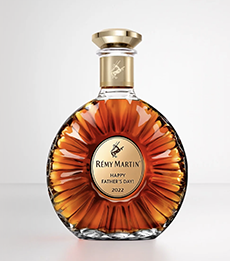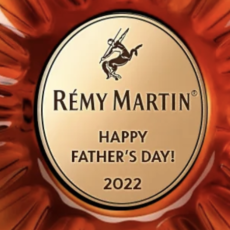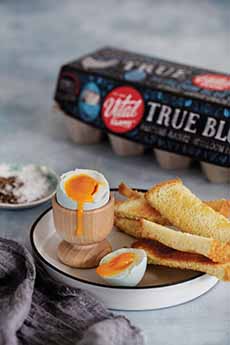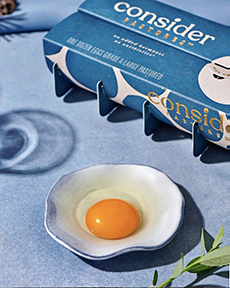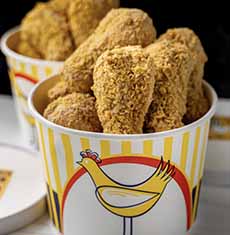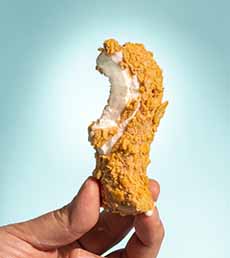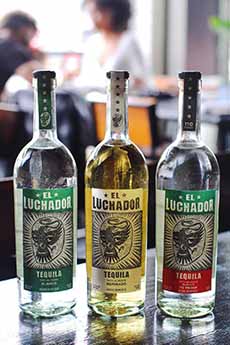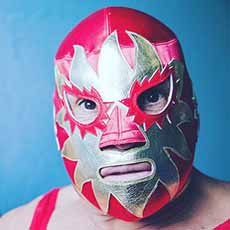|
Today’s the day to get out the snifters and the Cognac, and relax at sunset as you relish both (the Cognac and the snifters, that is).
If you’ve never enjoyed a snifter of Cognac, you’re in for a treat.
Two of our favorite recipes with Cognac:
Brandied Fruit
Lobster Newburg
WHAT IS COGNAC?
Brandy is a spirit distilled from grapes. Cognac is a type of brandy made only from specific white wine grapes; brandy can use white and/or red grapes.
Cognac is produced in the Charente and Charente-Maritime départements of France and is named for the town of Cognac that is in that locality.
Brandy is not a legally protected name and can be made anywhere in the world. The name “brandy” comes from the Dutch branewijn, “burned wine.” There’s more about that in the footnote* below.
Cognac can only be made in the Charente and Charente-Maritime départements.
By law, Cognac must be twice distilled in copper pot stills (alembic stills), then aged at least two years (often considerably longer) in French oak barrels, made from oaks in the forests of Limousin or Tronçais.
Cognac matures in those barrels, the same way that fine whiskey and wines mature.
Every step in the production of Cognac must follow strict rules imposed by the Bureau National Interprofessionnel du Cognac (BNIC), can be called Cognac.
> The history of Cognac is below.
THE DIFFERENT CLASSIFICATIONS OF COGNAC
There are official quality grades of Cognac based on age, established by the BNIC. As with all spirits, prices climb along with the length of barrel aging.
However, in the ongoing game of marketing new products, some Cognac producers release their own expressions (for example, C by Courvoisier and Remy Martin Coeur de Cognac, and the more comprehensible Courvoisier 12 and Courvoisier 21), which have no official designation but can really tax a Cognac buyer to figure out what’s in the bottle.
Regardless, with any Cognac, the final product is a blend of cognacs from the various districts, aged for various periods of time.
Official designations include:
V.S. or Very Special, a blend in which the youngest Cognac in the blend has been aged for at least two years in cask.
V.S.O.P., or Very Superior Old Pale, is a blend in which the youngest Cognac is stored for at least four years in a cask, although the average age of the blend is much older.
Vieux is a grade between the official grades of VSOP and XO.
Napoleon is another grade between VSOP and XO, equal to XO in terms of minimum age, but it is generally marketed in-between VSOP and XO in terms of price.
XO, Extra Old, is a blend in which the youngest Cognac in the blend is stored for at least 10 years but is typically an average of 20 years.
Hors d’Âge, “Beyond Age,” refers to high quality Cognac that does not have an official age scale, but is considered equal to XO.
Vieille Réserve is, like Hors d´Âge, a grade beyond XO that does not have a specific, legal age minimum.
Extra, in which the youngest Cognac in the blend is 6 years of age, this grade is usually older than a Napoleon or an XO.
There are other age designations, but they are smaller productions and are not typically imported to the U.S.
Many firms bottle older Cognacs under proprietary names such as Anniversaire, Triomphe, or Cordon Bleu [source]. These are typically their top-of-the-line blends, packaged in beautifully designed decanters that are meant to be “keepers.”
Note that the designated age of a Cognac refers only to the time spent in wood. Distilled spirits cease to age after they are bottled.
The older the Cognac, the smoother, more complex, and more refined it becomes. While bottles aged 25 years can be found, it is rare for Cognac to remain in the cask beyond 40 or 50 years.
But you can find bottlings of great old Cognacs like Hennessy Paradis, a blend of a hundred eaux-de-vie‡ aged up to 130 years. Don’t ask the price (O.K., it’s $1149.99 [plus shipping!]).
Why are the names of some of the different grades in English, rather than French?
Because England was long the primary market for Cognac, the British importers/merchants named them.
WHAT IS FINE CHAMPAGNE COGNAC
More confusion: It has nothing to do with the wine-producing region of Champagne. There are six different districts (called cru in French) within the Cognac region.
Each has been graded by the government according to the quality of the grapes and Cognac produced there.
The best district is Grande Champagne, followed by Petite Champagne, Borderies, Fins Bois, Bons Bois, and Bois Ordinaires.
Fine Champagne† refers to the provenance of the grapes: a blend of Grande and Petite Champagne Cognacs, with at least half coming from Grande Champagne.
Grande Fine Champagne means that the Cognacs is made exclusively from Grande Champagne grapes.
A Cognac bottle labeled “Fine Champagne,” is as good as it gets in its age level.
THE HISTORY OF COGNAC
In the 16th century, Dutch merchants traveled to the Nouvelle-Aquitaine region on the southwest coast of France to buy wood, salt, and wine.
The wine proved difficult to transport, spoiling along the way, so the Dutch sought new ways to preserve it during shipping.
They began to distill the wine, like spirits. This concentrated the wine and gave it a higher alcohol strength which was a greater preservative.
Eventually, those from the Cognac area were regarded as superior to those of its neighbors, and by the start of the 17th century, producers started distilling the brandy twice as it yielded a smoother flavor.
Although the first stills were made by the Dutch, French distillers started perfecting the technique and soon developed their renowned “Charentaise” distillation methods.
Cognac traces its origins to the 17th century when wines of the Charente region were distilled to withstand shipment to distant European ports.
Over time, the brandy from the Cognac district in the center of the Charente was recognized as creating superior brandy.
By the start of the 17th century, Dutch producers were distilling the brandy twice for a smoother flavor. French distillers started perfecting the technique and soon developed their renowned “Charentaise” distillation methods [source].
___________________
*To test the purity of the wine, a portion was ignited. If the entire contents were consumed by a fire without leaving any impurities behind, then the liquor was good.
†The term means simply “open field”.
‡Eau de vie (eaux is the plural), pronounced oh-duh-VEE, is French for “water of life.” It’s a clear, colorless fruit brandy that is produced by means of fermentation and double distillation. It is the basis for brandy and Cognac. After the brandy and Cognac are aged in wood, they take on their amber color.
|
|

[1] In the Cognac area, a tulip-shape glass is used to enjoy the spirit (photo © BNIC | Aurélian Terrade).

[2] Many Americans are accustomed to drinking Cognac from a snifter. The shape helps to capture and focus the aromas (photo © Crate & Barrel).

[3] Remy Martin VSOP. VSOP is a younger, an “entry level” Cognac. VS is younger still, but too harsh (photo © Andrey Ilkevich | Unsplash).
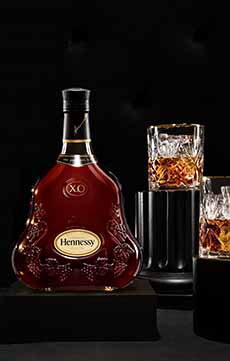
[4] If you can afford X.O. Cognac, you’ll get an idea of what the “good stuff” tastes like (photo © Hennessy Cognac).
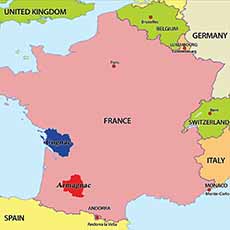
[5] A map of France. The Cognac region is in blue, the Armagnac-producing area is in red (photo © Zipps Liquors).

[6] Cognac pairs well with fine cheeses (photo © Murray’s Cheese).
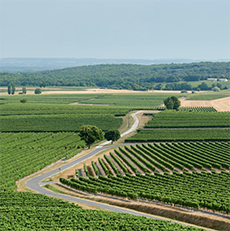
[7] Cognac vineyards grow ownly white grapes (photo © BNIC | Aurélian Terrade).
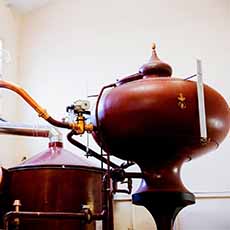
[8] An alembic (pot) still is used to distill Cognac (photos #8 and #9 © Cognac Official | Facebook).
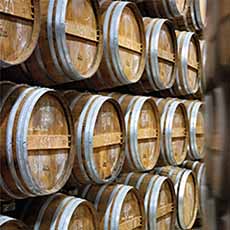
[9] Cognac is aged in barrels of white French Limousin oak.
|
